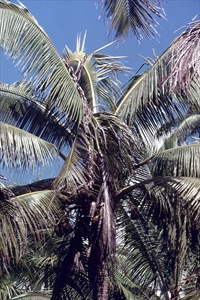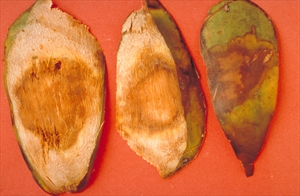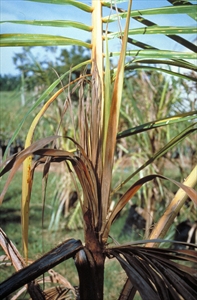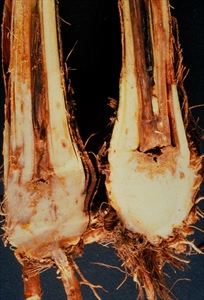Coconut bud rot
Pacific Pests, Pathogens, Weeds & Pesticides - Online edition
Pacific Pests, Pathogens, Weeds & Pesticides
Coconut bud rot (140)
Phytophthora palmivora. Note, there may be more than one species of Phytophthora in the Pacific islands causing bud rot. For instance, Phytophthora hevae is also said to occur, causing a bud and nut rot of coconuts in New Caledonia (Photos 2&3).
The disease is reported wherever coconuts are grown. It is recorded on coconut from Cook Islands, Fiji, Papua New Guinea, Samoa, Tonga, and Vanuatu. The report from Tonga needs confirmation.
Bud rot occurs on coconut and other palms (e.g., betel nut, oil palm), but Phytophthora palmivora infects many other crops (e.g., cocoa and papaya), as well as weeds, in Pacific island countries.
By the time symptoms appear, the disease is advanced with rotting of the bud and inner leaves (Photo 1). The first sign is a wilt or a bending of the spear leaf; sometimes the spear leaf becomes light green, but not always. The outer leaves then start to yellow from the top of the fronds downwards, and then turn brown. Yellow to light brown, sunken patches occur on the leaf stalks. As the disease progresses, the central leaves fall out as they become completely rotten at the base of the leaf stalks, leaving only a few outer leaves, which remain green for a while. However, after a few months they dry out and fall. A foul smell occurs as the bud rots. Nuts are also attacked; if infections occur at the point of attachment to the flower stalk it may lead to premature nutfall (Photos 2&3). Seedlings are also infected and killed (Photos 4&5).
Phytophthora water moulds survive in the soil and plant debris, probably in a dormant state as thick-walled spores ('chlamydospores'); these germinate producing spores ('sporangia') that are spread by wind, wind-driven rain and possibly by insects (see Fact Sheet no. 06).
Phytophthora palmivora is the common cause of bud rot of mature palms worldwide. A different species, Phytophthora katsurae, occurs in the Caribbean and West Africa. They are oomycetes or water moulds, not fungi. The water moulds infect the bud and cause a rot, which spreads to the base of other leaves and, eventually, kills the palm.
Bud rot is a rare disease in Pacific island countries. However, in Indonesia and the Ivory Coast, bud rot and premature nutfall caused by Phytophthora species are major disease problems. Mostly, the disease affects young palms, under 5 years. In Samoa, it is limited to a mountainous, cool, wet area. Outbreaks of a seedling bud rot caused by Phytophthora palmivora have been recorded from coconut nurseries in Vanuatu.
Look for a wilt of the spear leaf, which bends over slightly. Look at the bases of the petioles of the young leaves to see large yellow to brown rots. At this stage, the rot has probably completely destroyed the bud. Look to see that the outer leaves remain green for some months after the death of the spear and inner leaves.
The disease is favoured by high humidity such as that which occurs in low, badly drained plantations with dense stands, and in areas of high rainfall.
CULTURAL CONTROL
Cultural control is particularly important in the management of this disease:
- Make sure the plantation has good drainage; good drainage lowers the humidity in the plantation and reduces leaf wetness, which is needed for spore germination.
- Cut down and burn affected trees; do this as soon as the disease is seen.
- Plant palms at least 10 m apart; wide spacing allows air movement through the plantation, and reduces the times that leaves are wet and spores can infect.
RESISTANT VARIETIES
Tolerance to bud rot varies between varieties. Malayan yellow and red dwarf varieties are susceptible to bud rot caused by Phytophthora palmivora, but hybrids with dwarf and tall parents are less so. The Polynesian Tall and Rennell Tall are said to have good tolerance.
CHEMICAL CONTROL
Protectant products: In India, the disease is treated as soon as symptoms are seen by applying Bordeaux paste to the centre (crown) of the coconut palm after removing all the infected fronds and cleaning with water. Bordeaux paste is made by mixing together 100 g copper sulphate with 100 g quick lime (calcium oxide), each dissolved in 500 ml water, and then mixed together. Other copper-based fungicides are probably as effective.
Systemic products: Phosphorus acid (as potassium phosphonate) and metalaxyl have also been recommended and, in the Ivory Coast, a commercial injector is used to apply these products, and to manage epidemics of the disease.
Note, by the time symptoms are seen, it is probably too late to stop the disease, and the only remedy is to cut down the coconut and burn it.
____________________
When using a pesticide, always wear protective clothing and follow the instructions on the product label, such as dosage, timing of application, and pre-harvest interval. Recommendations will vary with the crop and system of cultivation. Expert advice on the most appropriate pesticides to use should always be sought from local agricultural authorities.
AUTHOR Grahame Jackson
Information (and Photo 1) Gerlach WWP (1988) Plant diseases of Western Samoa. Samoan German Crop Protection Project, Deutsche Gesellschaft für Technische Zusammenarbeit (GTZ) Gmbh, Germany; and CABI (undated) Coconut budrot Phytophthora palmivora. Plantwise Knowledge Bank. ((https://www.plantwise.org/knowledgebank/datasheet/409860); and Frison EA, et al. (eds.). 1993. FAO/IBPGR Technical Guidelines for the Safe Movement of Coconut Germplasm. Food and Agriculture Organization of the United Nations, Rome/International Board for Plant Genetic Resources, Rome. (https://www.bioversityinternational.org/fileadmin/user_upload/Coconut_361.pdf); and from Torres GA, et al. (2016) Bud rot caused by Phytophthora palmivora: A destructive emerging disease of oil palms. (https://apsjournals.apsnet.org/doi/pdf/10.1094/PHYTO-09-15-0243-RVW). Photos 2-5 Kohler F, et al. (1997) Diseases of cultivated crops in Pacific Island countries. South Pacific Commission. Pirie Printers Pty Limited, Canberra, Australia. Photos 2-5 Kohler F, et al. (1997) Diseases of cultivated crops in Pacific Island countries. South Pacific Commission. Pirie Printers Pty Limited, Canberra, Australia;
Produced with support from the Australian Centre for International Agricultural Research under project PC/2010/090: Strengthening integrated crop management research in the Pacific Islands in support of sustainable intensification of high-value crop production, implemented by the University of Queensland and the Secretariat of the Pacific Community








